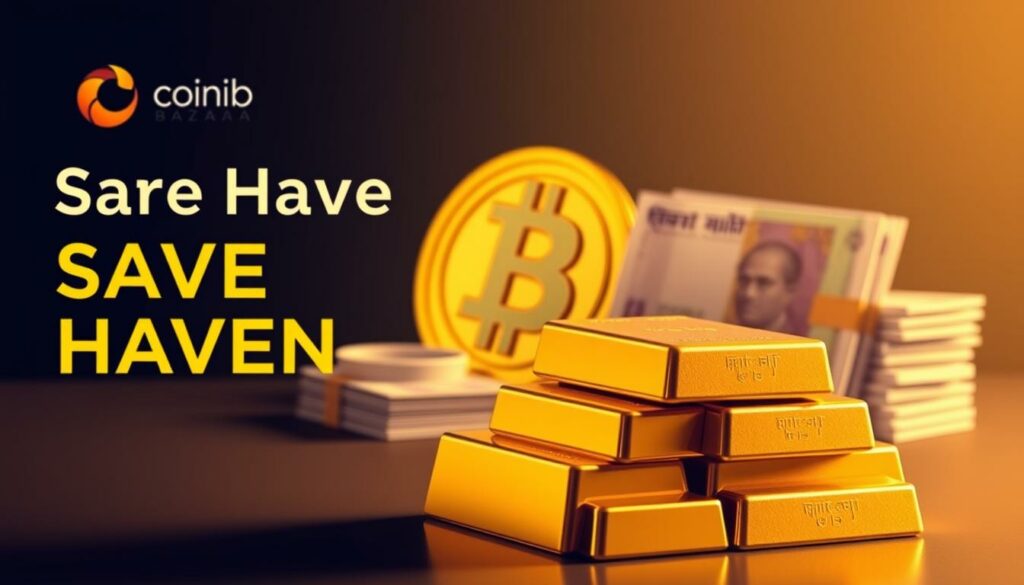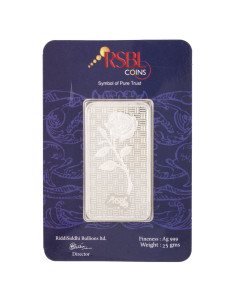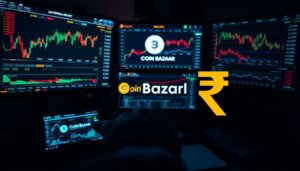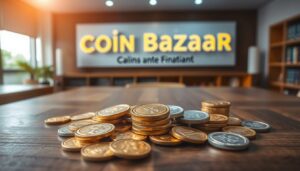Exclusive Deals & Trending Items


Muthoot Pappachan Swarnavarsham BIS Hallmarked Gold Heart Drop Earring of 3 gms in 22 KT 916 Purity Fineness
Shop Now

Muthoot Pappachan Swarnavarsham Gold BIS Hallmarked Ganesh Pendant of 2 gms in 22 KT 916 Purity Fineness
Shop NowIn times of economic uncertainty and geopolitical tensions, investors often turn to precious metals as a safe haven. Historically, gold has been a reliable asset during such crises. It provides a hedge against inflation and market volatility.
Recently, the gold price has surged due to global instability and inflationary pressures. As an investor, you may be wondering how to navigate the gold market during these uncertain times. Understanding the dynamics of gold mining and the appeal of bullion and gold coins can help you make informed decisions.
Key Takeaways
- The gold market is influenced by geopolitical events and economic uncertainty.
- Precious metals like gold serve as a safe haven during crises.
- The gold price has risen due to inflationary pressures and global instability.
- Understanding gold mining and investment options like bullion and gold coins is crucial.
- Investors should consider the historical significance of gold during economic downturns.
The Historical Relationship Between Gold and Global Crises
Gold is often seen as a safe place to put money, especially when the world is in turmoil. Its price goes up when things get uncertain. This has happened many times in history.


Gold’s Performance During Major Historical Crises
Gold has done well in big crises. For example, during World War II, its price went up a lot. This was because of the war’s uncertainty and instability. In 2008, when the financial world was shaky, gold prices also rose.
Some big events that have affected gold prices include:
- The Great Depression
- World War II
- The Cold War
- The 2008 financial crisis
Why Investors Turn to Gold in Uncertain Times
Investors choose gold when things are unsure. They see it as a safe place to keep their money. Gold’s value isn’t linked to any one currency or government. This makes it a solid choice when the economy is shaky.
Here’s why people invest in gold:
- Diversification: Gold can spread out the risk in a portfolio.
- Safe-haven asset: Gold is a safe choice, helping protect against market ups and downs.
- Inflation protection: Gold’s value often goes up when prices rise, making it a good defense against inflation.
Understanding Gold as a Safe Haven Asset
When global crises hit, investors look for safe havens. Gold is a top choice. It’s known for keeping its value during tough times.
What Makes Gold a “Safe Haven”
Gold stands out as a safe haven because it holds its value when markets shake. It’s not linked to any single economy or currency. This makes gold a solid choice during crises.
Key characteristics that make gold a safe haven include:
- Liquidity: Gold is easily bought and sold globally.
- Universal acceptance: Gold is recognized and valued worldwide.
- Store of value: Gold has historically maintained its purchasing power over time.
Comparing Gold to Other Safe Haven Assets
Investors compare gold to other safe havens like government bonds and cryptocurrencies. Knowing the differences helps them make better choices.
Gold vs. Government Bonds
Government bonds are seen as safe because they’re backed by the government. But, their value can change with interest rates and credit risk. Gold’s value isn’t as tied to these factors, making it a distinct safe haven.
Gold vs. Cryptocurrencies
Cryptocurrencies, like Bitcoin, are seen as modern safe havens. But, they’re more volatile and have a shorter history than gold. Studies show gold is a more dependable safe haven during global crises.


The Psychology Behind Gold Buying During Crises
When global crises hit, gold’s appeal grows. This is due to a mix of fear, uncertainty, and its cultural value. You might ask, why do people turn to gold in tough times?
Fear, Uncertainty, and Precious Metals
Fear and uncertainty push people towards gold. As tensions rise or economies wobble, investors look for safe-haven assets. Gold, known for its reliability, is often chosen. Its emotional appeal as a value keeper grows stronger during crises.
Cultural Factors Influencing Gold Demand
Cultural factors play a big role in gold demand, especially in India. Gold is more than just an investment; it’s a part of cultural practices.
Indian Cultural Perspectives on Gold Security
In India, gold symbolizes prosperity and security. During festivals and weddings, gold purchases skyrocket. This cultural importance boosts gold demand, making India key to global gold prices.
| Cultural Event | Impact on Gold Demand |
|---|---|
| Weddings | Significant increase in gold purchases |
| Festivals (e.g., Diwali) | Moderate to high increase in gold demand |
Understanding these cultural aspects is key for investors. By grasping the psychological and cultural reasons behind gold buying, you can make better investment choices.
Gold Price Movements During Different Types of Crises
Gold has always been a safe choice during tough times. But, its price changes a lot depending on the crisis. Knowing these changes helps investors make better choices.
Financial Crises and Gold Performance
When the economy hits a rough patch, gold prices often go up. This happened in 2008 when the world was on the edge of a financial disaster.
The table below shows how gold prices changed during big financial crises:
| Crisis | Gold Price Before | Gold Price After | Percentage Change |
|---|---|---|---|
| 2008 Financial Crisis | $800/oz (2007) | $1,045/oz (2009) | +30.6% |
| Asian Financial Crisis (1997) | $290/oz (1997) | $320/oz (1998) | +10.3% |
Geopolitical Conflicts and Gold Prices
Gold prices also go up during wars and conflicts. This is because these situations make investors nervous and look for safe places to put their money. For example, the 2022 conflict between Russia and Ukraine made gold prices jump.
Pandemic-Related Economic Disruptions
Pandemics, like COVID-19, affect gold prices in a special way. At first, prices might drop because of money problems. But then, they can rise when governments start spending more and investors look for safe investments.
The COVID-19 pandemic showed that gold can be both unpredictable and strong during health crises. This makes it clear how important it is to understand the market.
Key Geopolitical Events That Historically Impacted Gold Prices
Gold prices have changed a lot over history. Big events have made people want safe assets like gold.
Major Wars and Military Conflicts
Wars have always made gold prices go up. For example, during World War II, gold prices soared. This was because of the war’s uncertainty and economic troubles.
Recently, the Middle East conflicts have also pushed gold prices up. People looked for safe places to put their money.
Key examples include:
- The Gulf War in 1990-1991
- The Iraq War in 2003
- The ongoing conflict in Ukraine
Political Regime Changes
Changes in governments, like coups or revolutions, also affect gold prices. These changes bring uncertainty and can cause economic problems. This makes investors choose gold.
Examples of significant political regime changes affecting gold prices include:
- The Iranian Revolution in 1979
- The collapse of the Soviet Union in 1991
International Sanctions and Trade Wars
Sanctions and trade wars also play a role in gold prices. These events can mess up global trade and cause economic worries. This leads people to buy gold.
Notable examples include:
- Economic sanctions imposed on Russia
- The US-China trade war
Knowing how these events affect gold prices can help you invest better.
The Gold Market in India: Cultural and Investment Perspectives
In India, gold is more than just a precious metal. It’s a key part of the country’s culture and investment world.
Cultural Significance of Gold in Indian Households
Gold is highly valued in Indian culture. It stands for prosperity, good luck, and joy. It’s a common gift at weddings and festivals, showing love, respect, and celebration.
Gold jewelry and ornaments are not just for show. They also represent marital status and family history.
Festival and Wedding Season Gold Buying Patterns
Festivals and wedding seasons boost gold demand in India. These times see a surge in gold buying, as it’s seen as lucky to buy gold then.
The wedding season is especially big for gold demand. Ornaments are key in Indian weddings, showing the bride’s wealth and status.
| Festival/Wedding Season | Average Gold Demand Increase |
|---|---|
| Diwali | 20% |
| Akshaya Tritiya | 30% |
| Wedding Season (Oct-Dec) | 40% |
How Indian Investors Approach Gold During Global Uncertainty
When the world economy is shaky, Indian investors often choose gold. They see it as a safe investment, protecting against inflation and market ups and downs.
Indian investors like physical gold, like jewelry and coins. They also go for digital gold options like Gold ETFs and Sovereign Gold Bonds. These offer a safe and easy way to invest in gold.
Timing Your Gold Investments: Early Warning Signs of Global Crises
Investors aiming to profit from gold’s safe-haven status must spot early signs of global crises. The right timing of gold investments can greatly enhance returns during economic downturns.
Economic Indicators to Watch
Watch for economic signs like inflation rates, GDP growth, and unemployment. High inflation and slow growth, or stagflation, hurt economies. This pushes investors towards gold. Stay updated with financial news and government reports.
Geopolitical Tension Signals
Geopolitical tensions rise with conflicts, sanctions, and political instability. Keep an eye on news about major powers and conflict zones. Increased tensions often lead to more gold buying as investors seek safety.
Market Sentiment Analysis Techniques
Understanding market sentiment means looking at investor behavior and trends. Track gold ETF flows, futures market positions, and indicators like the VIX index. Gold usually does well when fear and uncertainty are high.
By keeping up with these indicators, you can make better choices about when to invest in gold. Whether it’s through economic signs, geopolitical tensions, or market sentiment, being proactive is crucial.
Different Forms of Gold Investment During Crises
Gold’s appeal during global crises is clear. Knowing the various gold investment forms helps Indian investors make smart choices. Each option has its own benefits and traits.
Physical Gold: Coins, Bars, and Jewelry
Many Indian investors choose physical gold, like coins, bars, and jewelry. Investing in physical gold means you hold a real asset. But, it also means dealing with storage and insurance costs.
Gold coins and bars from trusted mints ensure purity and authenticity. Jewelry, too, is a physical gold investment. Yet, its value can also depend on craftsmanship and design.
Paper Gold: ETFs, Futures, and Mining Stocks
Paper gold includes financial products linked to gold’s value. Gold ETFs are a favorite, letting you invest in gold without physical storage. Futures contracts and mining stocks offer different risks and potential gains.
Gold ETFs mirror gold’s price, making it easy to invest. Futures contracts involve set prices and dates, risky but with big potential gains.
Digital Gold Options for Indian Investors
Digital gold options are becoming more popular, offering a new way to invest. Consider Gold Accumulation Plans and Sovereign Gold Bonds for your digital gold strategy.
Gold Accumulation Plans
Gold Accumulation Plans let you invest a set amount regularly in digital gold. It’s stored electronically, making it easy to build up your gold without physical storage.
Sovereign Gold Bonds
Sovereign Gold Bonds are government securities tied to gold. They’re a safe gold investment, earning interest. These bonds trade on stock exchanges, offering liquidity.
| Investment Option | Key Features | Risks Involved |
|---|---|---|
| Physical Gold | Tangible asset, can be held and stored | Storage and insurance costs, authenticity concerns |
| Gold ETFs | Tracks gold price, convenient, no storage needed | Market volatility, tracking errors |
| Sovereign Gold Bonds | Government-backed, earns interest, traded on stock exchanges | Interest rate risk, liquidity risk |
Gold Mining Stocks vs. Physical Gold During Global Uncertainty
Gold mining stocks and physical gold are two different ways to invest. They both deal with gold prices but have unique traits. These traits affect how they perform and the risks they carry.
Performance Comparison During Past Crises
Gold mining stocks have historically seen bigger gains than physical gold in tough times. But, this also means they can lose more value. This makes them riskier than physical gold.
Risk-Reward Analysis for Different Investor Profiles
Conservative investors often choose physical gold for its stability. It directly ties to gold prices. On the other hand, aggressive investors might pick gold mining stocks. They offer the chance for bigger gains, but with more risk.
| Investment | Risk Level | Potential Return |
|---|---|---|
| Physical Gold | Low | Stable |
| Gold Mining Stocks | High | Higher |
Accessibility of Mining Stocks in Indian Markets
Indian investors can buy gold mining stocks through international brokers. They can also invest in Indian funds that own shares in global mining companies. This way, they can diversify their portfolio and get into the gold mining sector.
The Role of Central Banks in Gold Markets During Crises
Gold markets are greatly influenced by central banks’ buying patterns and monetary policy during crises. Central banks, being key players in the global economy, can significantly affect gold prices. You might wonder how their decisions impact the gold market.
Central Bank Gold Buying Patterns
Central banks worldwide have been buying gold, adding it to their reserves. This trend is especially notable during economic uncertainty. For example, countries like China, Russia, and India have boosted their gold reserves. They do this to diversify their assets and protect against currency fluctuations.
In 2022, central banks bought 456 tons of gold, a big jump from previous years. This buying supports gold prices and shows confidence in gold as a safe asset.
“Central banks’ gold buying is a long-term strategy, driven by the need to diversify reserves and protect against financial shocks.” – World Gold Council
How Monetary Policy Affects Gold Prices
Monetary policy decisions, like interest rate changes and quantitative easing, greatly impact gold prices. Lowering interest rates or quantitative easing weakens the currency, raising gold prices. Raising interest rates, on the other hand, strengthens the currency and lowers gold prices.
It’s important to consider how these policies interact with other economic factors. This includes inflation expectations and currency devaluation, which also affect gold prices.
| Monetary Policy Action | Impact on Gold Prices |
|---|---|
| Lowering Interest Rates | Increases Gold Prices |
| Quantitative Easing | Increases Gold Prices |
| Raising Interest Rates | Decreases Gold Prices |
Reserve Bank of India’s Gold Policies
The Reserve Bank of India (RBI) is key in India’s gold market. The RBI manages its gold reserves, sometimes buying gold to replenish them. In 2020, it bought 20.53 tons of gold from the International Monetary Fund (IMF), showing its interest in gold.
The RBI’s gold policies aim to stabilize India’s foreign exchange reserves and support the economy.
Understanding central banks’ role in gold markets is crucial for investors during crises. By watching central bank activities and monetary policy, you can make better gold investment decisions.
Case Study: Gold Performance During the 2008 Financial Crisis
Gold’s actions during the 2008 financial crisis are key for today’s investors. As the crisis grew, gold’s performance caught the eye of investors everywhere.
Initial Price Movements and Recovery
At first, gold prices fell with global stocks, showing a wide asset sell-off. But as the crisis worsened, investors looked for safe places, and gold prices began to climb. By 2008’s end, gold not only bounced back but also hit new highs. This was due to its seen safety and the US dollar’s weakening.
Indian Gold Market Reaction
In India, the gold market reacted powerfully to the global crisis. As global gold prices went up, Indian buyers, who see gold as a safe place, bought more. The cultural importance of gold in India, especially during festivals and weddings, also boosted demand. The falling Indian rupee against the US dollar made gold more pricey but still appealing as a protection against economic uncertainty.
Lessons for Today’s Investors
The 2008 crisis showed the value of diversifying and gold’s role as a safe asset. Today, knowing how gold acted in past crises can guide investment plans. It’s vital to understand what drives gold prices, like global tensions, economic signs, and currency shifts, to wisely invest in gold.
Case Study: Gold During the COVID-19 Pandemic
Gold prices soared during the COVID-19 pandemic. This was due to global economic uncertainty and a desire for safety among investors. As the pandemic grew, gold prices saw big swings. These were influenced by government actions, economic data, and how investors felt.
Price Trajectory Throughout the Crisis
Gold prices first fell sharply, then rebounded strongly. At the pandemic’s start, prices dropped due to a cash demand surge and liquidity issues. But, with stimulus from governments and central banks, prices climbed to new peaks.
Factors That Drove Gold’s Performance
Several factors played a role in gold’s performance during the pandemic. These included:
- Economic stimulus packages and monetary policies
- Rising global debt levels
- Currency fluctuations
- Investor risk aversion
As Warren Buffett noted, “Price is what you pay. Value is what you get.” During the pandemic, investors saw gold as a valuable asset, pushing its price up.
Impact on Indian Gold Consumption and Investment
The pandemic had mixed effects on Indian gold consumption and investment. Physical gold demand was low at first due to lockdowns and uncertainty. But, digital gold investment soared. The pandemic showed gold’s value in Indian homes, as a cultural item and investment.
| Indicator | Pre-Pandemic | During Pandemic |
|---|---|---|
| Gold Price (USD/oz) | 1,500 | 2,070 |
| Indian Gold Demand (tonnes) | 800 | 600 (physical), +20% digital |
Common Mistakes When Buying Gold During Crises
Buying gold during crises can be wise, but knowing the pitfalls is key. When tensions rise and uncertainty grows, gold becomes a safe choice. Yet, making smart choices is vital to avoid costly errors.
Timing Errors and Emotional Decision-Making
One big mistake is buying gold at the wrong time. Fear or greed can lead to bad timing. It’s important to have clear goals and strategies before investing.
Overlooking Storage and Insurance Costs
Many investors forget about the extra costs of physical gold. These include storage and insurance, which can reduce returns. For example, keeping gold in a vault can cost 0.5% to 1% of its value each year.
| Storage Option | Annual Cost |
|---|---|
| Home Safe | 0% |
| Bank Vault | 0.5% – 1% |
| Private Vault | 1% – 2% |
Authentication and Purity Concerns in the Indian Market
Checking gold’s authenticity and purity is crucial, especially in India. Gold jewelry is a big part of the culture. Look for hallmarked gold and verify its purity through trusted sources.
Hallmarking Standards to Look For
The Bureau of Indian Standards (BIS) hallmark is key for gold purity in India. Investors should look for the BIS hallmark. It shows the gold meets purity standards.
By knowing these common mistakes, investors can make better choices when buying gold during crises.
Building a Crisis-Resistant Portfolio with Gold
Investors focus on making a portfolio that can handle financial shocks. Gold is key in this effort. By setting the right gold percentage, mixing it with other assets, and rebalancing, you can craft a crisis-resistant portfolio.
Optimal Allocation Percentages
Finding the best gold percentage depends on your goals, risk level, and market trends. A common advice is to put 5% to 15% of your portfolio in gold. “Gold has always been a solid shield against inflation and market ups and downs,” notes a top financial expert.
Balancing Gold with Other Assets
A good portfolio mixes stocks, bonds, and gold. Gold’s unique ability to not move with other assets makes it a great addition. It’s vital to find a balance that fits your investment goals.
Rebalancing Strategies During and After Crises
Keeping your portfolio balanced is key. During crises, gold might increase in value, so you might need to adjust your portfolio to stay on track.
Indian-Specific Portfolio Considerations
In India, cultural and market factors influence gold investments. Knowing these can help you make better choices about gold in your portfolio.
By using these tips, you can build a strong investment plan. It will use gold’s power to safeguard and grow your wealth, even in tough times.
Tax Implications of Gold Investments in India
Thinking about gold as a safe investment? It’s key to know the tax rules in India. This knowledge helps you make better choices with your gold investments.
Short-term vs. Long-term Capital Gains
Gold investments in India face capital gains tax. The tax rate changes based on the gain’s duration. Long-term gains are taxed less than short-term ones. You need to hold gold for over three years to get long-term gains.
| Holding Period | Tax Rate |
|---|---|
| Less than 3 years | Short-term capital gains tax applies |
| More than 3 years | Long-term capital gains tax applies |
Sovereign Gold Bonds and Tax Benefits
Sovereign Gold Bonds (SGBs) have tax perks. If you hold SGBs until maturity, you won’t pay capital gains tax. The interest from SGBs is taxed based on your income tax rate.
GST Implications for Physical Gold Purchases
Buying physical gold? Remember the Goods and Services Tax (GST) rules. GST is applied to the making charges of gold jewelry, with rates varying by type. For gold bars and coins, GST is on the transaction value.
Conclusion: Navigating Future Crises with Gold in Your Portfolio
Gold has always been key in investment portfolios during crises. It offers a safe place and diversifies your investments. Knowing how gold relates to global crises helps you face future uncertainties better.
When crises hit, gold often shines, making it a great part of a crisis-proof portfolio. Keep an eye on economic signs, global tensions, and market feelings to time your gold buys.
Adding gold to your portfolio can help you get through tough times. Whether you choose physical, paper, or digital gold, having a solid plan is crucial. This way, you’re ready to handle crisis situations and make smart gold investment choices.


















